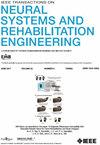经颅磁刺激与下丘脑核磁声耦合刺激对初级运动皮层的影响
IF 4.8
2区 医学
Q2 ENGINEERING, BIOMEDICAL
IEEE Transactions on Neural Systems and Rehabilitation Engineering
Pub Date : 2025-04-29
DOI:10.1109/TNSRE.2025.3565258
引用次数: 0
摘要
皮层和深部的成对刺激有可能诱导皮层可塑性增强。理想情况下,这种刺激应该是无创的和精确控制的。提出了一种新的配对刺激方法,将经颅磁刺激(TMS)与经颅磁声耦合刺激(TMAS)相结合,称为TMS - TMAS。虽然使用TMS刺激初级运动皮层(M1),但脉冲磁场与聚焦超声场耦合,通过磁声耦合效应实现基于tmas的丘脑底核(STN)的聚焦电刺激。基于脉冲时间依赖的可塑性(STDP),通过精确控制磁脉冲和超声发射的时间来诱导皮质可塑性。实验系统实现了皮层聚焦磁刺激,横向分辨率为4.3 mm,纵向分辨率为2.8 mm, M1区磁场强度为1.6 T。此外,在STN区域实现了横向分辨率为1.6 mm、纵向分辨率为9.9 mm、耦合电场强度为280 mV/m的深聚焦电刺激。体内动物实验表明,TMS-TMAS可增强运动诱发电位(MEP)振幅,减少反应潜伏期。仿真和实验结果证实,TMS-TMAS对皮层和深部核实现了高空间分辨率、无创成对刺激,且刺激序列满足STDP标准时,皮层可塑性增强。这种方法为无创配对刺激提供了一种很有前途的方法,有望推动脑科学研究和涉及深部脑结构的神经精神疾病的康复。本文章由计算机程序翻译,如有差异,请以英文原文为准。
Cortical Plasticity Induced by Pairing Primary Motor Cortex Transcranial Magnetic Stimulation With Subthalamic Nucleus Magneto-Acoustic Coupling Stimulation
Paired cortical and deep stimulation has the potential to induce enhanced cortical plasticity. Ideally, such stimulation should be noninvasive and precisely controlled. A novel paired stimulation method, combining transcranial magnetic stimulation (TMS) with transcranial magneto-acoustic coupled stimulation (TMAS), named TMS–TMAS, was proposed to achieve such stimulations. Although the primary motor cortex (M1) is stimulated using TMS, the pulsed magnetic field is coupled with a focused ultrasound field to achieve TMAS-based focused electrical stimulation of the subthalamic nucleus (STN) via the magneto-acoustic coupling effect. Cortical plasticity is induced by precisely controlling the timing of magnetic pulse and ultrasound emissions based on spike timing-dependent plasticity (STDP). The experimental system achieved cortical-focused magnetic stimulation with a transverse resolution of 4.3 mm, a longitudinal resolution of 2.8 mm, and a magnetic field intensity of 1.6 T in the M1 region. Additionally, deep-focused electrical stimulation with a transverse resolution of 1.6 mm, a longitudinal resolution of 9.9 mm, and a coupled electric field intensity of 280 mV/m in the STN region was realized. In vivo animal experiments demonstrated that TMS–TMAS enhanced the amplitude of motor evoked potential (MEP) and reduced response latency. Simulation and experimental results confirmed that TMS–TMAS achieves high spatial resolution, noninvasive paired stimulation of the cortex and deep nuclei, and induces enhanced cortical plasticity when the stimulation sequence satisfies the STDP criteria. This method provides a promising approach for noninvasive paired stimulation and is expected to advance brain science research and the rehabilitation of neuropsychiatric disorders involving deep brain structures.
求助全文
通过发布文献求助,成功后即可免费获取论文全文。
去求助
来源期刊
CiteScore
8.60
自引率
8.20%
发文量
479
审稿时长
6-12 weeks
期刊介绍:
Rehabilitative and neural aspects of biomedical engineering, including functional electrical stimulation, acoustic dynamics, human performance measurement and analysis, nerve stimulation, electromyography, motor control and stimulation; and hardware and software applications for rehabilitation engineering and assistive devices.

 求助内容:
求助内容: 应助结果提醒方式:
应助结果提醒方式:


